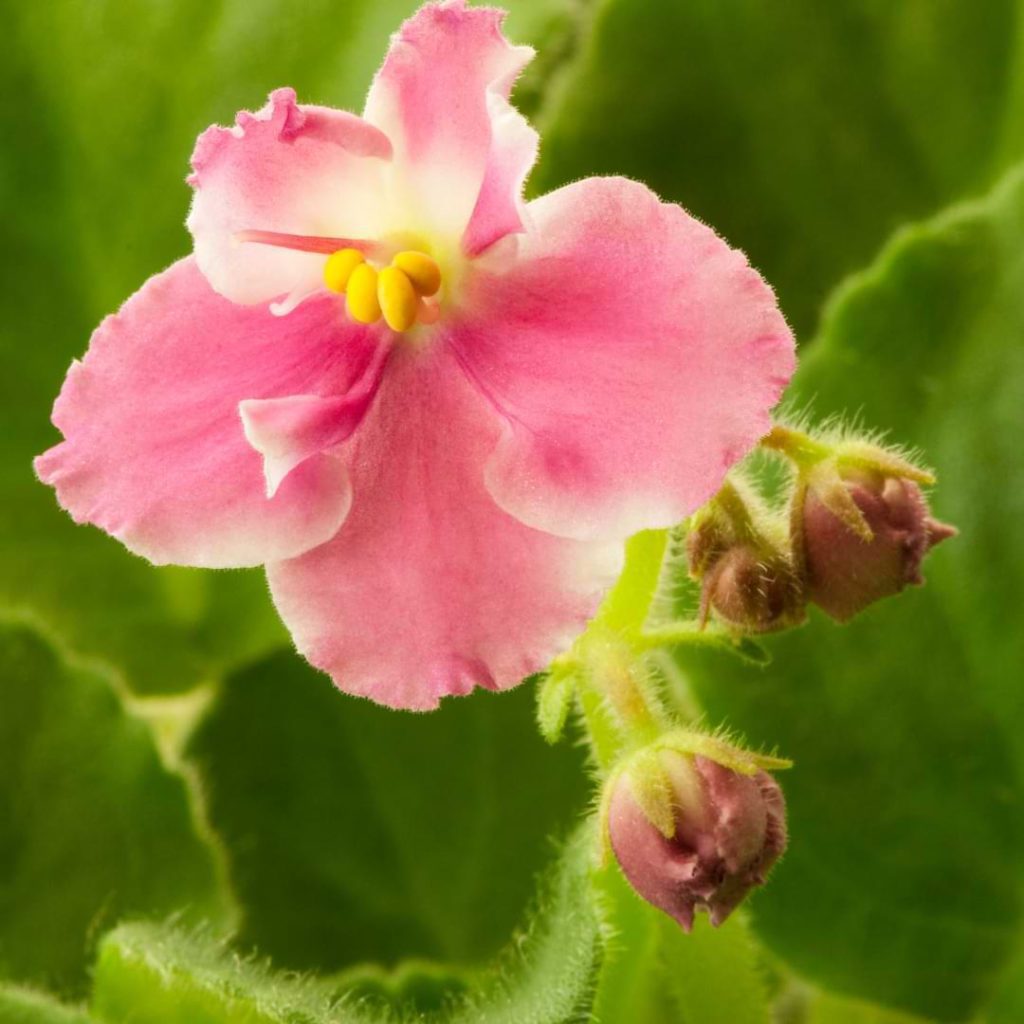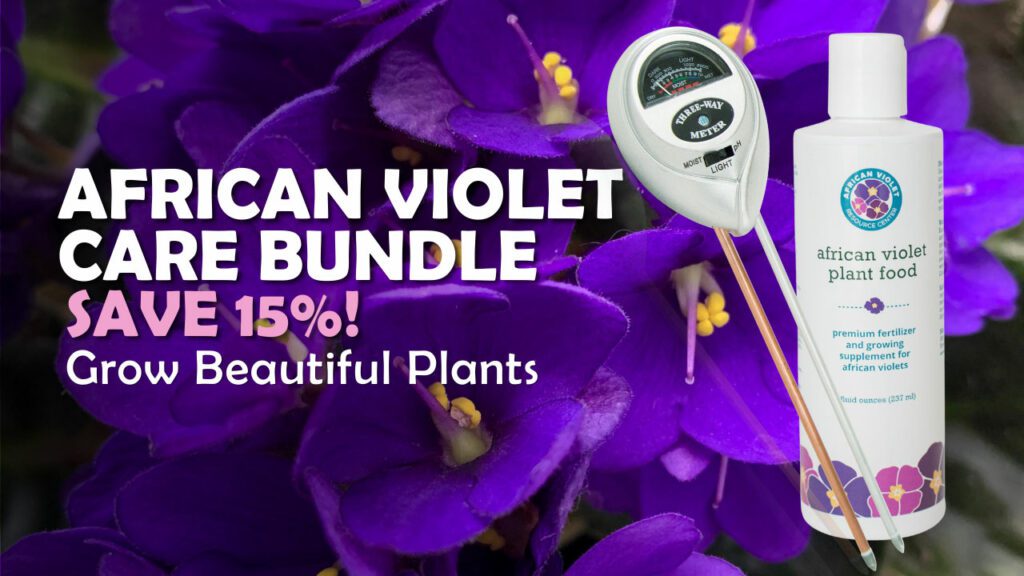African violets have a reputation of being easy to care for. It’s true that compared to other beloved houseplants, African violets are fairly easy to keep alive. Despite their beautiful appearance, they aren’t delicate things that droop at any minor inconsistency. However, like other houseplants, African violets do sometimes face damage from diseases and pests.
You’ll be relieved to know that problems with diseases and pests attacking African violets don’t happen on a regular basis, and most diseases and pests that bother African violets are easy to prevent with good care.
That being said, sometimes even with the best care, your African violet may show signs of disease or pests. Keep reading to find out how you can identify the problem and treat your African violets.
African Violet Diseases on Leaves
Usually the first visible sign of disease in African violets appears on the leaves. Given just how beautiful and vibrant African violet leaves are, you’re certain to notice if something is affecting your African violet’s foliage.
Here are a few of the most common diseases to watch for.
Bacterial Blight
Bacterial blight looks like black rot attacking an African violet’s crown and roots. The spots that show up sometimes appear brown or dark red rather than black. You’ll see sticky threads appear if you cut the spots apart.
Causes, Prevention, & Treatment
Bacterial blight is caused by the bacteria Erwinia chrysanthemi, which is spread by insects or the use of dirty tools.
You can prevent bacterial blight by cleaning tools between use and by keeping infected plants away from healthy plants.
To treat this disease, use sterilized scissors to cut away any leaves or roots that have spots or show signs of infection. Make sure to clean your tools between cuts so you don’t spread the disease any further.
Botrytis Blight
The first warning signs of botrytis blight are gray blooms and a lack of growth at the crown. Then the leaves will start to develop fuzzy gray and brown spots. Finally, the African violet will wilt. Observers often describe that the African violet appears to “melt.”
Causes, Prevention, & Treatment
Botrytis blight is caused by the fungi Botrytis cinerea, which develops in areas that are cool and moist.
You can prevent botrytis blight by giving your plants plenty of room for good air circulation and avoiding top watering.
To treat this disease, isolate plants that show signs of infection and use sterile tools to remove any portions of the plant that have spots. Use a fungicide to keep the infection from returning. Botrytis blight spreads quickly, so there’s no guarantee you’ll be able to save an infected African violet. However, if you act quickly, you may be able to stop an infection from spreading.
Powdery Mildew
The first sign of powdery mildew on African violets is the appearance of a light powder that seems to cover the leaves and flowers. There may also be discoloration in the blooms. As the powdery mildew progresses, the blooms will fall off and the plant’s growth will halt.
Causes, Prevention, & Treatment
Powdery mildew is a fungus that pops up when African violets do not have adequate air circulation in a humid environment.
You can prevent powdery mildew by making sure there’s enough space between your plants to allow for enough airflow. If your African violets are in a high-humidity environment, use a fan to help the air circulate better.
To treat plants with powdery mildew, first isolate the affected plants to prevent the mildew from spreading. Try treating the plants with a homemade mix to begin with. Mix one tablespoon of baking soda with one gallon of water, and coat the infected plant with the mixture. If that doesn’t work, then you may have to use a fungicide made to treat powdery mildew. Fungicides can contain harsh chemicals, so follow the directions carefully during use.
Other African Violet Fungus
Some diseases that affect African violets don’t show up on the leaves at first; instead, some diseases target the crown or the roots. You likely won’t see the effects of any disease that targets the roots until it has spread enough to affect other areas.
Here’s what to watch for.
Phytophthora Crown Rot
One of the most severe diseases African violets face, the symptoms of Phytophthora crown rot include the crown becoming mushy or darkening.
Causes, Prevention, & Treatment
Phytophthora crown rot is caused by the Phytophthora fungus and tends to develop when African violets are left sitting in soil that is waterlogged.
To prevent Phytophthora crown rot, avoid overwatering African violets and use a well-draining potting soil in a container that allows excess water to escape. These actions should keep crown rot from developing.
Treating Phytophthora crown rot is extremely difficult. In most cases, the best plan of action is to get rid of the plant, the soil, and the container to prevent the fungus from spreading to other African violets. If you decide to try to treat crown rots, you’ll need to remove the infected parts of the plants and replant the African violet in a new container. The fresh soil should be treated with a fungicide; however, this treatment is not usually successful.
Pythium Root Rot
Root rot is difficult to notice in African violets. The main visible symptoms are leaves that turn yellow, wither, and fall off. However, these same symptoms appear in African violets that are not being adequately watered.
Causes, Prevention, & Treatment
Root rot is caused by the fungus Pythium ultimum, which thrives in wet conditions (if you mistake root rot for underwatering and try to water more often, you’ll cause the fungus to spread faster).
Prevent Pythium root rot by allowing the soil to almost dry out between waterings. The top inch or two of the potting soil should be dry before you water again.
There isn’t a good treatment for root rot, so the best thing to do with an infected African violet is get rid of the plant and the potting soil. You can reuse the container if you sterilize it before using with a new plant.
Rhizoctonia Crown Rot
The signs of Rhizoctonia crown rot are wilting, collapsing, turning black, and dying. An African violet may display red infected tissue right at the soil line.
Causes, Prevention, & Treatment
This disease is caused by the fungus Rhizoctonia, which develops quickly in soil that drains poorly and remains moist for too long.
Prevent Rhizoctonia crown rot from developing by making sure your African violet’s soil is quick-draining and doesn’t hold on to excess water. Avoid watering too frequently, and choose a container that allows excess water to escape.
There is no good way to treat this disease. Immediately remove the infected plant. Get rid of the plant and the soil without allowing it to come into contact with other plants. You can reuse the African violet’s container if you sterilize it before using it for another plant.

African Violet Pests
Since African violets are kept indoors, they don’t usually have too many issues with pests. Still, it is possible to unknowingly bring pests into your home, especially when you get new plants.
Here’s what you need to know about African violet pests.
Foliar Nematodes
The most common visible symptom of foliar nematodes is wilting leaves. If you look on the underside of your African violet’s leaves, there will be shiny brown and yellow spots appearing between the veins on plants infected with nematodes.
Causes, Prevention, & Treatment
Foliar nematodes are tiny worms you can’t see with the naked eye, which enter African violets through wounds or through the stomata.
Prevent nematode infections by isolating new plants before bringing them into the same area as other plants. Always use pasteurized soil when repotting plants and disinfect pots before reusing.
There’s no good treatment for foliar nematodes. While there are a few pesticides available that target foliar nematodes, you need a pesticide license to buy those. For everyone without a pesticide license, the best thing to do is get rid of infected plants before the pests spread to other plants.
Cyclamen Mites
Cyclamen mites are the most damaging mites that bother African violets. Their presence has two main symptoms: excessive plant hairs will grow from the leaves and the leaves will begin to curl up around the edges.
Causes, Prevention, & Treatment
These mites are very tiny but can be seen with a magnifying glass. Cyclamen mites have eight legs and can be either white, yellow, or brown. Some of these mites can also carry the fungus botrytis, which will damage African violets even further.
The best way to prevent a mite infestation is to isolate new plants until you’re certain they’re not infected. You can also carefully examine new plants to look for pests, but this is only effective if the pests are large enough to be visible.
To treat a mite infestation without using a chemical treatment, you can spray neem oil or Leaf Armor on infected plants. Make sure to keep infected African violets isolated until the infestation is under control. If neem oil doesn’t work, you move on to treating infected plants with a chemical insecticide while being careful to follow the directions on the label for treatment.
Mealybugs
Signs of a mealybug infestation are fairly similar to other problems, including white specks on the leaves or stems, sticky honeydew on the leaves, or black fungus on the leaves. However, mealybugs are usually large enough to be visible, and they leave a sticky trail.
Causes, Prevention, & Treatment
Mealybugs are tiny insects about 1/16 to ¼ inch in size and are covered in a sticky, white, powdery substance. These pests feed on African violet sap.
The best way to prevent a mealybug infestation is to inspect new plants before bringing them home. Check both the plant itself and the soil for signs of mealybugs and their eggs. These pests sometimes hide just below the surface of the soil.
Minor mealybug infestations can be treated by dipping a cotton swab in rubbing alcohol (70% isopropyl alcohol) and then touching any visible insects. Repeat the process with new mealybugs as you see them.
Major mealybug infestations require a more drastic approach. Spraying neem oil or Leaf Armor on the leaves and stems consistently can sometimes treat a heavy mealybug infestation. Neem oil is non-toxic to people, so we prefer to start with neem oil first. If neem oil is not effective, you can use a chemical pesticide designed to target mealybugs. Be sure to follow the instructions closely.
Other Problems
There are a few other issues that you may notice with your African violets from time to time.
Water Spots
Also known as ring spots, water spots are white or yellow spots that appear on African violet leaves in areas where water has splashed on the leaves.
Causes, Prevention, & Treatment
Water spots are caused by a difference between leaf temperature and water temperature when water is dropped on an African violet leaf. The drastic drop in temperature actually decreases photosynthetic activity and destroys the composition of leaf cells.
Prevent water spots by bottom watering rather than top watering African violets. If you do decide to top water your African violets anyway, use room-temperature water and avoid allowing water to splash on the leaves.
There’s no way to undo water spots that appear; however, the spots don’t spread and won’t harm your African violet’s growth. The spots are just unattractive, so you can remove leaves with water spots, but sometimes this gives the African violet an odd shape.
Failure to Bloom
Sometimes African violets stop blooming. While this can sometimes be the result of a disease or pests, it’s more likely to be caused by improper care.
Causes, Prevention, & Treatment
Lack of light, water, fertilizer, or even waiting too long to repot can all cause African violets to stop blooming. An African violet that is stressed or does not have all the resources it requires to bloom will also stop blooming.
To keep your African violet blooming year-round or nearly year-round (African violets can bloom 10-12 months a year with proper care), make sure your African violet has everything it needs to thrive.
See our guide to How to Care for African Violets to help ensure you’re giving your African violet proper care.
To encourage African violets to bloom, you must figure out which area of care is lacking. Once you address that problem, your African violet should resume blooming again. For me, lack of light tends to be the biggest issue; I just don’t have a window that gets optimal sun during the winter months. I don’t worry if my African violet stops blooming over the winter months, but if you have a similar problem and you want year-round blooms, try supplementing the natural light using artificial lights.
African Violet Diseases FAQ
How do you revive a wilted African violet?
African violets can wilt for a variety of reasons. The most common reason for wilting is overwatering or underwatering. Check the soil, and make sure you’re watering correctly. If the top 2 inches of the soil are dry, it’s time to water. If the top 2 inches of the soil are still wet, hold off on watering.
Why are the bottom leaves of my African violet dying?
Overwatering is generally the cause of the bottom leaves of an African violet dying. Allow the soil to dry out more between waterings. While other issues can be the cause, in most cases, adjusting your watering schedule will likely fix the problem.
What is the life span of an African violet?
African violets can live for a long time. With proper care, African violets have a life span of between 20 and 50 years.
African Violet Diseases and Pests Final Thoughts
Having a disease or pest attack your African violets can be disappointing. After all, you’re hoping for a hardy, beautiful houseplant when you get an African violet.
The good news is that most diseases and pests are preventable with a little extra vigilance on your part. Make sure you water your African violet correctly, give it adequate air circulation, and generally keep it healthy. Also, isolate new plants to check for pests before placing them near the rest of your plant collection. This will keep pests from being introduced to the African violets you already have.
Join the African Violet Club!
Whether you’re just starting out or are a seasoned grower, African Violet Resource Center has everything you need to help your plant grow vibrant and strong. Explore our other articles, visit our online shop, and connect with other houseplant lovers in our Facebook group to learn everything you need to know about this rewarding hobby!
More Great African Violet Resources
Best African Violet Plant Stands and Pots
How Do You Propagate and Grow African Violets From Seeds?
6 Reasons Your African Violet Won’t Bloom and How to Fix Them







